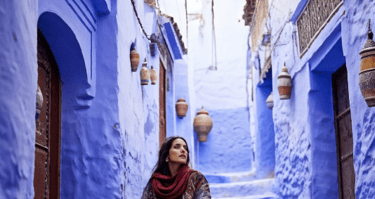Moroccan Ceramics: A Cultural Legacy Boosting Tourism
ECONOMY & TOURISM


Morocco's dynamic culture, extensive history, and breathtaking scenery set it apart. The pottery industry is a significant manifestation of the nation's cultural heritage among its many creative traditions. This ancient craft serves not only to produce functional items but also as a dynamic embodiment of Morocco's identity, creativity, and historical influences. As the pottery business continues to flourish, it plays a key role in boosting tourism and establishing ties between tourists and the local culture.
Historical Origins of Moroccan Pottery
The roots of Moroccan pottery date back thousands of years, shaped by several civilizations that have inhabited the area. The Phoenicians, Romans, and Berbers each had a role in the development of pottery methods and styles.
Ancient Influences
The Phoenicians disseminated sophisticated pottery skills via their expansive trading networks, but the Romans added glazing, augmenting the aesthetic allure and utility of ceramics. The Berbers, intimately linked to their territory and customs, developed distinctive styles marked by earthy hues and organic forms. This amalgamation of influences has produced a diverse array of ceramic traditions that differ markedly by area. Regional Diversity Currently, Moroccan pottery is renowned for its unique regional patterns. The blue and white ceramics of Fez are renowned for their elaborate floral motifs and geometric patterns, often inspired by Islamic art. Artisans in Marrakech produce vibrant ceramics characterized by striking colors and whimsical forms, embodying the city's vivacious essence. Safi's traditional pottery stands out with its minimalist yet refined designs, emphasizing both utility and craftsmanship.
Artistry and Genuineness
Moroccan ceramics' craftsmanship exemplifies the skills and methods passed down through the centuries. Artisans, sometimes operating in family-owned workshops, use ancient techniques that have persisted essentially unaltered for generations. The artisan meticulously creates each clay item, making it distinctive and indicative of their ingenuity. Natural Materials The use of natural resources is fundamental to Moroccan ceramics. Artisans often get clay from nearby riverbeds, establishing a strong connection between their works and the earth. Natural pigments sourced from rocks and plants produce the vibrant hues characteristic of Moroccan ceramics. This dedication to authenticity not only elevates the visual value but also enriches the cultural importance of each item.
Traditional Methods
The ceramic fabrication process has several complex stages. Artisans start by kneading the clay, molding it manually, or using a potter's wheel. After being molded, the pottery is allowed to cure before undergoing firing in a kiln. Following the firing process, artists often embellish with elaborate motifs and use glazes to get the desired finish. This intricate procedure necessitates a deep understanding of materials and processes, which artists acquire through years of experience and apprenticeship.
Cultural Importance
Moroccan pottery transcends mere craftsmanship; it encapsulates the narratives, symbols, and traditions of its people. The creative designs often include cultural importance, including geometric patterns, floral motifs, and calligraphic inscriptions that reflect local beliefs and traditions.
Narrative Expression Using Art
Every pottery item conveys a narrative, linking the craftsman to their ancestry and the overarching tale of Moroccan culture. Geometric patterns may represent unity and harmony, while floral motifs embody the region's natural beauty. This narrative element enhances the pottery's significance, making it both an aesthetic pleasure and a cultural relic. Pottery as Cultural Heritage Moroccan pottery, a living tradition, serves as a medium for safeguarding cultural heritage. Through their craftsmanship, artists preserve ties to their forebears and facilitate the continuation of cultural traditions. This legacy is particularly significant in a swiftly evolving world, as globalization presents challenges to conventional creative forms.
Enhancing Tourism
The pottery industry significantly contributes to Morocco's tourism promotion. The lively souks and artisan workshops attract tourists eager to witness the delicate pottery-making process firsthand. Numerous travelers seek authentic Moroccan pottery to engage with local culture and acquire a piece of Morocco for their homes. Genuine Experiences Tourists are increasingly searching for immersive experiences that enable them to connect directly with artists. Workshops where visitors may try their hand at pottery-making give a unique chance to learn about the trade while supporting local craftspeople. This hands-on approach improves the visitor experience and creates a greater awareness of the cultural relevance of the art form.
Artisan Markets and Festivals
Pottery-focused craft fairs and festivals honor this historic art form, drawing both residents and visitors. These events highlight the elegance of Moroccan ceramics and provide craftsmen an opportunity to exhibit their talents and narratives. The emergence of eco-tourism has fostered an increased respect for traditional crafts, as a growing number of tourists want to support sustainable practices and local craftsmen.
Economic Consequences The economic influence of the ceramic industry on local communities is significant. Pottery manufacturing sustains the lives of several artists and their families, aiding in the preservation of traditional crafts within an increasingly globalized context. The pottery business promotes local economies by attracting visitors, generating employment in both production and tourism-related industries, including hotel and transportation.
Assisting local communities By acquiring ceramics directly from craftspeople or local marketplaces, travelers contribute to the sustenance of these artisans's livelihoods. This direct assistance cultivates a feeling of community and promotes the maintenance of traditional customs. Moreover, several artists are increasingly acknowledging the significance of sustainable techniques, safeguarding the viability of their craft for future generations.
Obstacles and Prospects
Despite its rich tradition and growing potential, Morocco's pottery sector faces issues such as competition from mass-produced items and the need for modernization to adapt to changing market demands. The proliferation of inexpensive, machine-manufactured ceramics presents a substantial risk to the preservation of traditional artisanal skills.
Adopting Innovation
Nevertheless, a burgeoning trend among craftsmen seeks to integrate innovation with the preservation of old traditions. A multitude are integrating modern designs with ecological techniques, attracting a new generation of buyers who prioritize authenticity and ethical manufacture. This mix of traditional and contemporary elements enables Moroccan pottery to maintain its significance in a worldwide market.
Partnerships and International Presence
Collaborations between artists and designers, as well as collaborations with tourist organizations, may raise Moroccan ceramics' global prominence. Facilitating workshops and experiences that enable visitors to interact directly with artists enhances the relationship between cultural heritage and tourism.
Conclusion
The pottery business in Morocco vividly embodies the nation's historic cultural history and genuine ingenuity. It maintains ancient customs while promoting tourism, drawing people keen to engage with Morocco's rich creative heritage. The business can flourish by integrating its historical foundations with contemporary inspirations, preserving the craftsmanship of Moroccan pottery as a valued component of the nation's identity for future generations. In a society increasingly governed by mass manufacturing, the importance of genuine workmanship becomes more apparent. Moroccan pottery, characterized by its elaborate patterns and profound cultural importance, represents the resilient essence of a society that cherishes its legacy while anticipating the future. Visitors depart not just with exquisite antiques but also with a fragment of Morocco's illustrious past and a bond to its dynamic culture, making their visit memorable.
